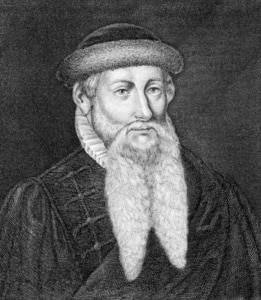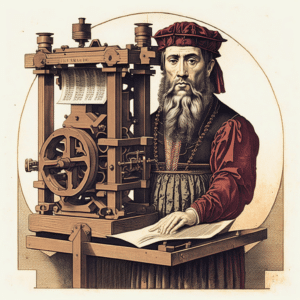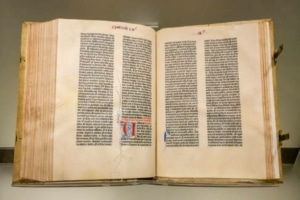DCPA NEWS CENTER
Enjoy the best stories and perspectives from the theatre world today.
Enjoy the best stories and perspectives from the theatre world today.
Ask any historian to name the most significant invention in history and many would say the printing press.
Created by Johannes Gutenberg around 1450, the moveable-type printing press revolutionized the publishing industry. Previously, the limited number of books in Europe were largely written by hand on a type of parchment called vellum. The work was painstakingly slow, resulted in errors on subsequent copies and were extraordinarily expensive.

Johannes Gutenberg
In an interview with the History Channel, Professor S. James Gates, Jr. of the University of Maryland explained the importance of Gutenberg’s invention: “I believe that the printing press was our species intellectual ‘Big Bang.’ Knowledge, up to that point, was the property of only a small number of people, whether it be royalty or a religious order and the ability to produce books is severely limited because to produce a book, a person has to sit with one book and painstakingly copy it into a second version.”
If only someone had thought about printing a book on Johannes Gutenberg.
Unfortunately, little is known about Gutenberg and what has been pieced together has large gaps or conflicting information. While accounts vary and the specific timeline is a bit vague, it is believed that Gutenberg was born around 1400 in Mainz, Germany. Early in life, he was an apprentice to a goldsmith (whether his own father or an employer is unclear), and those skills are believed to have informed the printing press.
During civil unrest in Mainz, his family was forced to relocate and soon thereafter he is believed to have enrolled in the University of Erfurt around 1418. Very little is known about him in the 20 ensuing years. He reappears as a leader of an investment in the mass production of mirrors, which were intended to reflect holy relics to crowds clamoring for a look while on display in locations throughout Germany. When this particular venture failed, Gutenberg was met with anger by fellow investors. To placate them, he shared the details of his secret project — the printing press.
Building upon the woodblock technique developed in China between 600 and 756 AD, Gutenberg created individual metal letters to set the type for a sheet of paper. The characters were created by carving a letter into the end of a metal stick, which was them hammered into a copper bar to create a mold. This was inserted into another mold and filled with molten metal to produce an individual letter or character, which could be used thousands of times before needing to be replaced.
The individual letters were then used to form the words for a page in precise lines of type. Unlike the woodblock technique, which required an entire page to be hand-carved prior to printing (thus rendering it useless once the page had been printed), Gutenberg’s approach allowed for reuse of the metal letters, easy correction of spelling errors, and imprinting onto cheaper materials. Unlike hand written documents, the metal type was legible and consistent between copies.
 And compared to both alternate techniques, Gutenberg’s printing press was fast. In fact, he could print more books in a week than had previously been produced in a year. “It plants the seed of the notion that you can get machines to do what people used to do,” Professor Gates continued.
And compared to both alternate techniques, Gutenberg’s printing press was fast. In fact, he could print more books in a week than had previously been produced in a year. “It plants the seed of the notion that you can get machines to do what people used to do,” Professor Gates continued.
“You start to see the end of the artisan era and the beginning of the manufacturing era,” added James Meigs, Editor-In-Chief, Popular Mechanics “If you think about the impact that had, it’s hard to underestimate it.”
The History Channel enumerates seven ways Johannes Gutenberg and the printing press changed the world:
1. A global news network was launched
Once it was determined that ships could distribute books, pamphlets and papers from port to port throughout Europe, the printing business expanded rapidly. However, literacy was slower to catch up. Captivated by news of foreign lands, locals would gather in public places to hear the news read.
2. The Renaissance Kicked into High Gear
While efforts were already underway to use the ancient works of Plato, Aristotle, Caesar, Cicero and Seneca to educate Europe’s elite, translating, hand copying and distributing these works were extraordinarily laborious and expensive. Instead, the printing press made these educational resources more widely available and affordable, greatly accelerating the Renaissance.
3. Martin Luther becomes the First Best-Selling Author
Regarded as one of the most influential figures in Western and Christian history, Martin Luther benefitted from the mass printing of his Ninety-five Theses in which he detailed his opposition to Catholic Church clergy who were selling “indulgences” to reduce punishment for sins. Previously, such religious opposition was quickly squashed, but the widespread distribution of Ninety-five Theses was more difficult to silence and ultimately led to the Protestant Reformation.
4. Printing Powers the Scientific Revolution
Prior to the printing press, science was a solitary occupation. But, “once moveable type came into play and the production costs went down, knowledge flourished,” said Mark Frauenfelder, Editor-In-Chief of Make. Scientists were not only able to obtain new information quickly, but the information was more accurate and trustworthy. Francis Bacon who is credited with developing the scientific method cited the printing press as one of three inventions that forever changed the world.
5. Fringe Voices Get a Platform
Before the printing press, those in places of authority (be it in religion or politics) were able to easily control public opinion and silence opposition. However, once mass printing was available, individuals had a way to more broadly express their opinions that was much more difficult to suppress.
6. From Public Opinion to Popular Revolution
Just as the fringe voices found their voice, “the democratization of knowledge in the Enlightenment era led to the development of public opinion and its power to topple the ruling elite.” Individuals fighting against the establishment leveraged public opinion, which was greatly informed by the distribution of information, to gain momentum and effect change.
7. Machines ‘Steal Jobs’ from Workers
As Meigs noted above, the printing press was the first invention to introduce the idea that machines could replace workers. It all but eliminated scribes and bookmakers. At the same time, it created an entirely new publishing industry and can be seen as a precursor to the Industrial Revolution.
While all of these history-making advances can point back to the printing press, perhaps the greatest is the increase in literacy. According to Tatiana Schlossberg in The State of Publishing: Literacy Rates, “in the 14th century, 80 percent of English adults couldn’t even spell their names. When Johannes Gutenberg invented the printing press in 1440, only about 30 percent of European adults were literate.”

Gutenberg Bible on permanent display at the Library of Congress in Washington, DC
She goes on to say that “literacy rates in England grew from 30 percent of about 4 million people in 1641 [1.2 million] to 47 percent of 4.7 million in 1696 [2.21 million]…reaching 62 percent among the English population of roughly 8 million by 1800 [4.96 million.]”
“The ability to have access to this world of knowledge, was absolutely transformational for Europe,” said Meigs. “You had this huge boom in literacy and with the awareness that there was such a thing as a book, came curiosity about what was going on around the world.”
In an effort to expand upon the opportunity of enlightenment, ensure approval of the Church and guarantee a hefty profit, Gutenberg chose to leverage the Church’s need for bibles in all of its places of worship. He set upon printing an affordable, easy to read and aesthetically pleasing version and thus The Gutenberg Bible was produced in 1456. It is estimated that 180 copies were printed — 135 of which were on paper and 45 on vellum. Of the original 180 copies only 49 are known to exist, less than half of which are complete. The last sale of a complete Gutenberg Bible sold for $2.2 million in 1978 and is now valued at $35 million.
While just on the verge of tremendous success, one of Gutenberg’s creditors, Johann Fust, demanded repayment of his investment. Unable to pay the debt, Gutenberg was forced to relinquish his printing press and the business. Fust attempted to take credit for Gutenberg’s invention, but Gutenberg was granted the title of “Hofmann” (gentleman of the court) by Archbishop Adolph von Nassau, which recognized his contributions and guaranteed him a modest income plus clothing, grain and wine allowance until his death in 1468.
Unfortunately, he would never know that his invention would literally change the course of history by connecting people with information, with literacy and with one another. Gutenberg once said: “Let us be brave enough to dare even what we cannot do.” And so he was.
Informed by various website resources including Britannica, WorldHistory.org and The History Channel.
